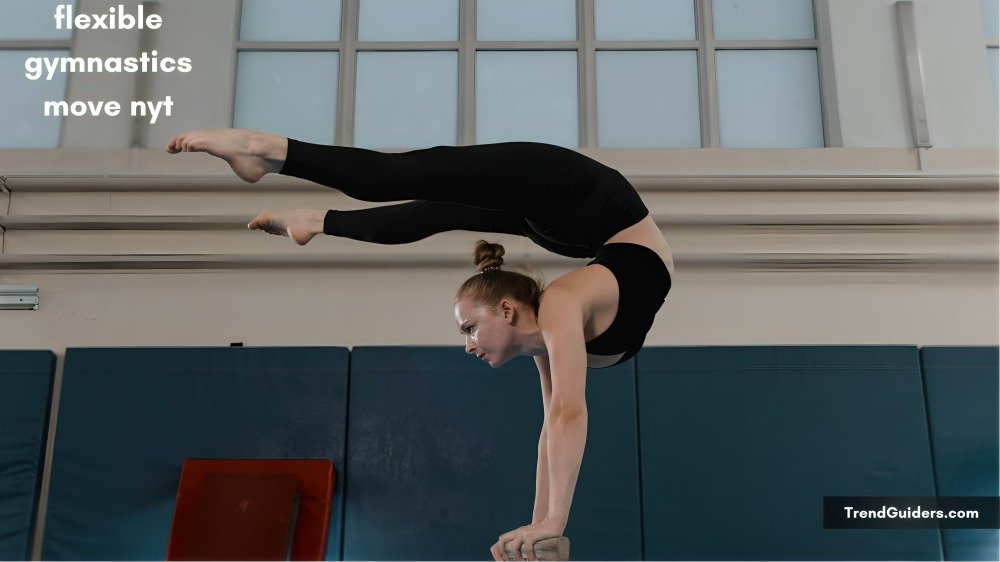Introduction to Flexible Gymnastics Move NYT
Nyt is a type of gymnastics move that is quite observant and as flexible and strong as a gymnast. Some of the most useful elements of skill acquisition in this discipline include acquiring flexible gymnastics. The Flexible Gymnastics Move NYT performance usually focuses on such accomplishments, which underlines the effort of the athletes and the aesthetics of the movements. In this guide, readers are introduced to the definition of flexible gymnastics moves, the role they play, and how to improve one’s ability to perform them.
What is a scheme of Flexible Gymnastics Move NYT?
The nyt gymnastics move exercises are activities that require certain amounts of flexibility in the body. Both of these steps are essential in Gymnastics since they are the most spectacular and expressive of the flexibility of the human body and its ability to bend or twist in all directions. Examples of such flips are the splits, back bending and myriad twists and turns, some OMG! These moves are not only displays of physical strength and aesthetics but they also are part of artistically styled sports.
The Labyrinth of Today’s Flexible Gymnastics Move NYT
This flexibility is a very important factor in gymnastics as it enables a performer to execute larger numbers as well as quality moves on the apparatus. Arabesque gymnasts can also do some difficult tricks more smoothly because their moves contain some amount of flexibility, which makes the performance look more graceful. This enhanced performance can be critical in very competitive environments, especially where observers ‘eyes’ are focused on producing the most polished moving formation.
To a certain extent, flexibility can be attributed towards the avoidance of injuries and optimal flexibility levels can be said to be high. Muscles and joints that have this feature are not easily injured such as getting a strain or sprain which is good for gymnasts in that they can continue training and performing. As in the case of the energies; flexibility also helps the athlete who has sustained a small injury to get back to his training schedule swiftly.
A gymnast’s move so famous that the mere mention of its name is likely an exercise in futility The New York Time
- The Splits: The splits are one of the earliest and basic forms of flexibility moves adopted in gymnastics. Legs swing includes swinging one of the legs to the right and left in a line parallel to the prover’s body. Performing the splits involves a lot of exercises that help to increase the flexibility of the hip and leg muscles. Other related splits include the front splits and medium splits that work the different muscle parts and increase the flexible gymnastics movement.
- The Backbend: A backbend is the kind of movement where the back of any gymnastic is bent in such a manner that the hair forms a bridge. This move requires great mobility to the spine and the shoulders. Practice is important to do a backbend effectively and the important idea is to do it gradually in order not to harm oneself. In the advanced levels, the backbend is included in the floor exercise movement such as the back walkover and back handspring.
- The Needle Scale: The needle scale is an aesthetical move in gymnastics where Nyt balances on one leg and has another leg stretched at the back skywards leaving a straight line from her head to her toes. This move asserts dexterity of the legs and back muscles, as well as flexibility at the ankles. To obtain a perfect needle scale one should not neglect the necessity of constant stretch and a special focus on strength training.
- The Contortionist Pose: Acrobatic elements of extortion force the gymnast to strain and make his body into various sharp angles. These poses usually entail such things as backbends, splits, and over splits, which show that the body of the athlete is flexible to the required extent. Acrobatic stances are phenomenal and at the same time contribute to the enhancement element of flair in gymnastics performances.
Points to Consider for the Efficient Practical Implementation of the Several Maneuvers of Limited Gymnastics NYT
Consistencies are always important when it comes to increasing flexibility. Integrate exercises that include stretching and exercising the different body muscles to gradually make them more flexible. It is important to hold each stretch minimum of 30 seconds for the muscles to stretch. After several days, add some time and force to how you stretch so you can continue progressing.
It is generally recommended that the warm-up rotates be taken before tackling any flexibility exercises. Proper warm-up assists in the circulation of blood in the body, especially in the muscles making them flexible and thus helps in preventing injuries. Dynamic stretch activities include moving your legs in circles and moving your arms around in circles as well as warm-up activities for stretching.
Conclusion
Learning the nyt of the spectacular kind of Flexible Gymnastics Move NYT is one of the exciting experiences that can be professionally useful since it is useful in raising or solving the most frequent problems experienced by gymnasts, makes them less prone to injuries, and makes them fit all the time. Applying the approach’s components that are, stretching exercises, efficient warm-up, gradual intensity increase, strength training, and seeking professional help, one will have remarkably increased flexibility, and successfully perform great gymnastic moves. Accept the process of mastering flexibility as a perfect challenge for the further development of gymnastic skills.
FAQs:
Here are some commonly asked questions to help you better understand and make the most of the information provided.
Q1: At what age should a gymnast begin flexibility training for gymnastics nyt?
It is recommended that flexibility exercises should begin in childhood; however, this does not mean that flexibility cannot be built in an adult. Of course, children and teenagers are usually more flexible thanks to their continuously developing organisms, yet adults are also capable of gaining a lot of flexibility if they focus on this aspect. Flexibility exercise is one of the health-enhancing exercises where the body of a human being is capable of being conditioned all the time irrespective of one’s age.
Q2: How many years does it take to be able to do Flexible Gymnastics Move NYT?
The duration taken to learn the flexible gymnastics moves depends on several factors that include the current flexibility, age of the gymnast, and training frequency of the artist. From just a few months of practice, patient results can start to show and with consistency, it dramatically increases. However, it may take for several years to master the additional moves in the game.
Q3: In this case, the following question can be put can flexibility be increased despite the age?
Yes, flexibility is a part that can be developed at any age. Even though often muscular pliability can improve more rapidly in young persons, adults also can increase their flexibility with regular and cautious exercise. The patient and persistency are the main things – one should give the body enough time to adapt to the stretching exercises.
Q4: It is safer to avoid stretching at all when in pain or when one experiences the following signs?
Stinging pain is not the same as the general uneasy feeling one expects with stretching exercises. However, if you are in pain, use the exercises no further and seek medical help from a health professional. An important distinction should be made between stretching discomfort and pain to prevent injuries. In this case, it will be important always to make sure that one is applying the right techniques and is not straining himself or herself.
Q5: How many times a week should you perform stretching exercises for the improvement of your Flexible Gymnastics Move NYT?
It is recommended that flexibility training should also be done regularly as part of the training regime. It is recommended that stretching should be done 5-6 times a week where each session targets a different group of muscles. It is established that an integration of stretching exercises, an appropriate warm-up, and strength-training programs will enhance flexibility after steady practice.



